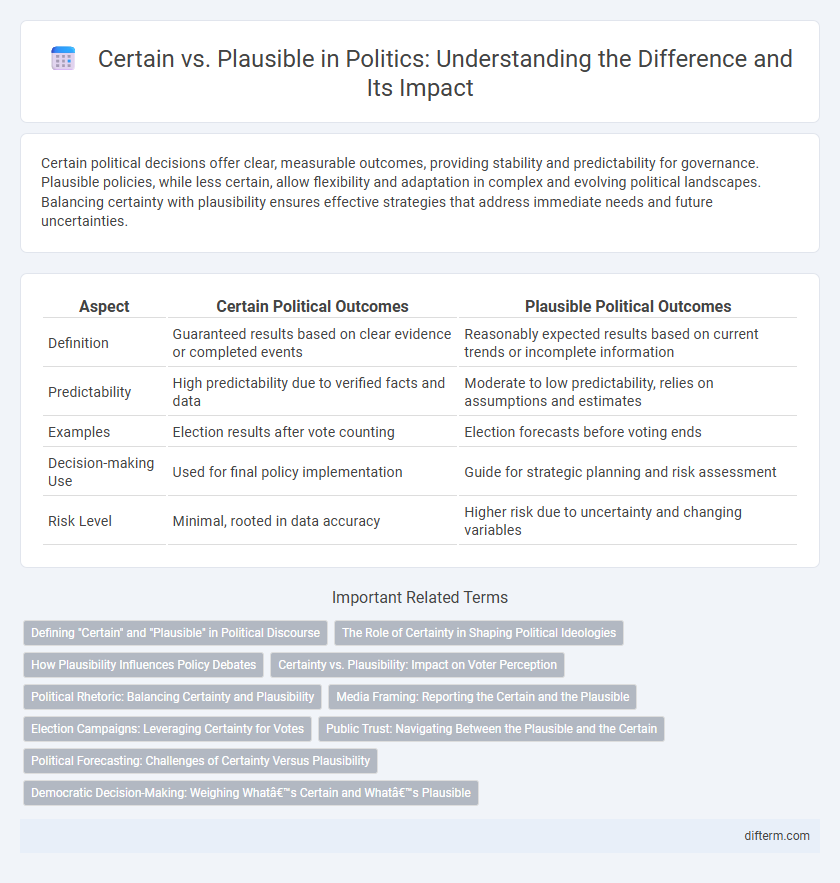Certain political decisions offer clear, measurable outcomes, providing stability and predictability for governance. Plausible policies, while less certain, allow flexibility and adaptation in complex and evolving political landscapes. Balancing certainty with plausibility ensures effective strategies that address immediate needs and future uncertainties.
Table of Comparison
| Aspect | Certain Political Outcomes | Plausible Political Outcomes |
|---|---|---|
| Definition | Guaranteed results based on clear evidence or completed events | Reasonably expected results based on current trends or incomplete information |
| Predictability | High predictability due to verified facts and data | Moderate to low predictability, relies on assumptions and estimates |
| Examples | Election results after vote counting | Election forecasts before voting ends |
| Decision-making Use | Used for final policy implementation | Guide for strategic planning and risk assessment |
| Risk Level | Minimal, rooted in data accuracy | Higher risk due to uncertainty and changing variables |
Defining "Certain" and "Plausible" in Political Discourse
In political discourse, "certain" refers to assertions supported by definitive evidence or consensus, indicating undeniable truth or fact. "Plausible" denotes claims that are credible or likely, but lack full verification or unanimous agreement, allowing room for doubt or alternative interpretations. Understanding the distinction between these terms helps navigate the complexities of political narratives and policy debates.
The Role of Certainty in Shaping Political Ideologies
Certainty in political ideologies solidifies core beliefs, guiding policies and voter behavior with unwavering conviction. Plausible alternatives introduce flexibility, encouraging dialogue and adaptation within political frameworks. The balance between certainty and plausibility shapes ideological rigidity or openness, impacting democratic engagement and policy evolution.
How Plausibility Influences Policy Debates
Plausibility shapes policy debates by framing which solutions are considered feasible and garner support among lawmakers and the public. Certain outcomes, backed by strong evidence, often drive consensus, but plausible scenarios introduce necessary complexity and caution in decision-making. Policymakers weigh these varying degrees of certainty to balance innovation with practical risk management in legislative processes.
Certainty vs. Plausibility: Impact on Voter Perception
Voter perception is significantly influenced by the certainty of political information versus its plausibility, shaping decisions at the polls. Certainty in communication often fosters trust and decisiveness, whereas plausible but uncertain claims may lead to skepticism and hesitation among the electorate. Research indicates that campaigns emphasizing clear, evidence-backed messages tend to achieve higher voter engagement and support compared to those relying on speculative assertions.
Political Rhetoric: Balancing Certainty and Plausibility
Political rhetoric strategically oscillates between certain statements and plausible claims to effectively persuade diverse audiences. Certainty in rhetoric reinforces confidence and authority, while plausible assertions invite engagement by acknowledging complexity and uncertainty. Balancing these elements enhances credibility, fostering trust without alienating critical or skeptical constituents.
Media Framing: Reporting the Certain and the Plausible
Media framing critically shapes public perception by emphasizing certain facts while presenting others as plausible possibilities, influencing voter beliefs and political discourse. The strategic selection of language and emphasis on certainty over plausibility can legitimize specific narratives and marginalize alternative viewpoints. This dynamic affects democratic engagement by directing attention to particular issues and shaping the boundaries of acceptable political debate.
Election Campaigns: Leveraging Certainty for Votes
Election campaigns that emphasize certainty through clear policy proposals and proven track records tend to build stronger voter trust and engagement. Candidates who balance plausible promises with actionable plans demonstrate reliability, increasing their chances of securing votes. Effective messaging leverages data-driven certainty to differentiate from vague or speculative claims, maximizing electoral support.
Public Trust: Navigating Between the Plausible and the Certain
Public trust in political institutions hinges on balancing plausible narratives and certain facts, as ambiguity can erode confidence in governance. Transparent communication of verified data strengthens legitimacy, while acknowledging uncertainties prevents misinformation. Effective leadership requires navigating this delicate line to maintain accountability and public credibility.
Political Forecasting: Challenges of Certainty Versus Plausibility
Political forecasting grapples with the tension between certainty and plausibility due to unpredictable variables like voter behavior, policy shifts, and geopolitical events. Models often rely on probabilistic data from polling trends, historical patterns, and socioeconomic indicators to generate plausible scenarios rather than definitive outcomes. Accurate forecasts demand continuous data analysis and adaptive methodologies to account for emergent political dynamics and reduce uncertainty.
Democratic Decision-Making: Weighing What’s Certain and What’s Plausible
Democratic decision-making relies on balancing certain facts with plausible scenarios to create effective policies. Lawmakers must prioritize verifiable data while considering the potential outcomes of emerging issues. This approach ensures that decisions remain grounded in reality while adapting to future uncertainties.
certain vs plausible Infographic

 difterm.com
difterm.com